The content on this page is no longer up to date. It will remain on ontario.ca for a limited time before it moves to the Archives of Ontario.
Search the Archives of Ontario or read the most recent information.
Air toxics – Select VOCs
VOCs are precursors of ground-level ozone and PM2.5. VOCs are emitted into the atmosphere from a variety of anthropogenic sources, including vehicles, fossil fuel combustion, steel-making, petroleum refining, fuel-refilling, industrial and residential solvent use, paint application, manufacturing of synthetic materials (e.g. plastics, carpets), food processing, agricultural activities and wood processing and burning. As stated in Section 2.0, general solvent use accounted for approximately 27 per cent of VOCs emissions in Ontario; the second largest source was the transportation sectors accounting for approximately 26 per cent. (Refer to Figure 1 for the estimates of Ontario’s VOCs emissions from point, area and transportation sources).
VOC Monitoring
Specialized, non-routine monitoring and analytical techniques are required to measure VOCs because they are usually present in the atmosphere in a gaseous form at ultra-trace concentrations. VOC samples are collected by automatically drawing ambient air into empty stainless steel canisters over a 24-hour period (midnight to midnight), following the National Air Pollution Surveillance (NAPS) sampling schedule (typically every sixth day) for urban sites. Concentrations for up to 161 selected VOCs are reported for each sample. For the purposes of this report, select VOCs (benzene, toluene, ethylbenzene, xylene, and 1,3-butadiene) data collected from eight ambient air monitoring stations (Windsor West, Sarnia, London, Kitchener, Hamilton Downtown, Brampton, Newmarket and Ottawa) between 2005 and 2014 are included in this discussion. Data from these sites are provided by ECCC as part of a co-operative federal-provincial program under NAPS and are available online at http://maps-cartes.ec.gc.ca/rnspa-naps/data.aspx. Annual 2014 statistics for the six select VOCs are presented in the Appendix.
Benzene, toluene, ethylbenzene, xylene (BTEX)
Benzene is a volatile aromatic hydrocarbon, which is primarily used in the production of plastics and other chemical products. Large quantities of benzene are obtained from petroleum, either by direct extraction from certain types of crude oils or by chemical treatment of gasoline. Benzene is classified as a human carcinogen (USEPA, 2016).
In 2014, benzene annual means ranged from 0.41 μg/m3 at Ottawa Downtown to 1.01 μg/m3 in Sarnia. Ontario’s 24h AAQC for benzene of 2.3 μg/m3 was exceeded on four occasions at both Sarnia and Hamilton Downtown, as displayed in Table 3. These measurements are reflective of all sources of benzene at the community level (for example, industrial activity and transportation) and are not specific to any one source and/or a specific point source. The 24-hour maximum benzene concentration reported at Sarnia was 17.37 μg/m3 capturing an episodic condition; Hamilton Downtown reported a 24-hour maximum of 4.01 μg/m3.
| Sarnia | Hamilton Downtown |
|---|---|
| 17.4 μg/m3 (Feb-04-2014) | 4.0 μg/m3 (May-29-2014) |
| 3.8 μg/m3 (Jul-22-2014) | 3.7 μg/m3 (Jun-16-2014) |
| 2.5 μg/m3 (Aug-03-2014) | 2.7 μg/m3 (Apr-29-2014) |
| 2.4 μg/m3 (Jan-11-2014) | 2.6 μg/m3 (Jun-22-2014) |
Note: Ontario’s 24-hour AAQC for benzene is 2.3 μg/m3.
Of the eight monitoring locations, the Ontario annual AAQC for benzene of 0.45 μg/m3 was exceeded at five sites – Windsor West, Sarnia, Kitchener, Hamilton Downtown and Brampton. London, Newmarket and Ottawa Downtown reported benzene annual means of 0.45 μg/m3, 0.42 μg/m3 and 0.41 μg/m3, respectively, merely meeting the annual AAQC. Over the 10-year period from 2005 to 2014, benzene concentrations have decreased 42 per cent as shown in Figure 19.
Toluene is an aromatic hydrocarbon used to make chemicals, explosives, dyes and many other compounds. It is used as a solvent for inks, paints, lacquers, resins, cleaners, glues and adhesives. Toluene is found in gasoline and aviation fuel. Studies reveal that toluene affects the central nervous system of humans and animals; however, there is little evidence to classify it as a carcinogen (USEPA, 2016).
In 2014, toluene annual means ranged from 0.73 μg/m3 in Newmarket to 1.91 μg/m3 in Sarnia. Figure 20 shows a 64 per cent decrease in toluene annual mean concentrations from 2005 to 2014.
Figure 19: Trend of Benzene Annual Means Across Ontario (2005 - 2014)
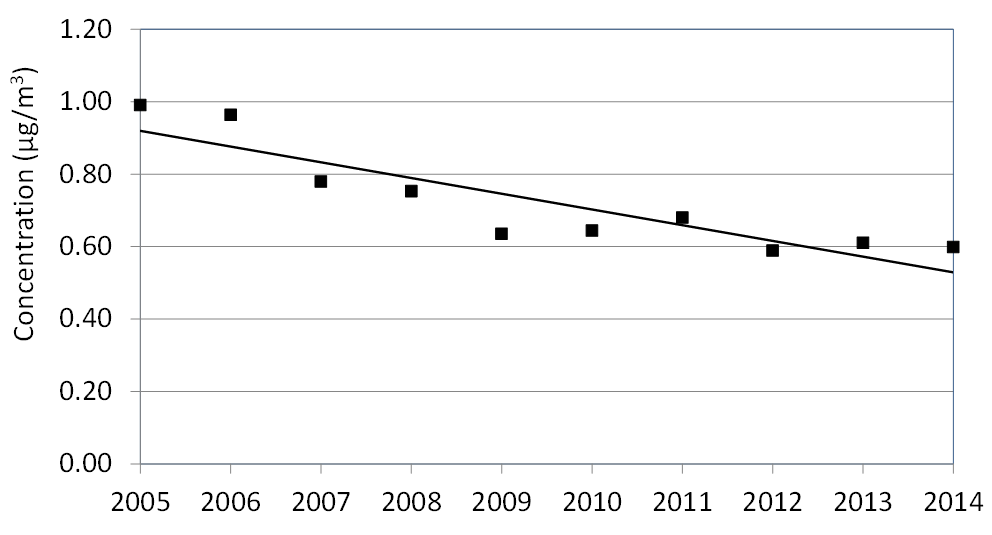
Note: 10-year trend is a composite mean based on 8 sites.
Figure 20: Trend of Toluene Annual Means Across Ontario (2005 - 2014)
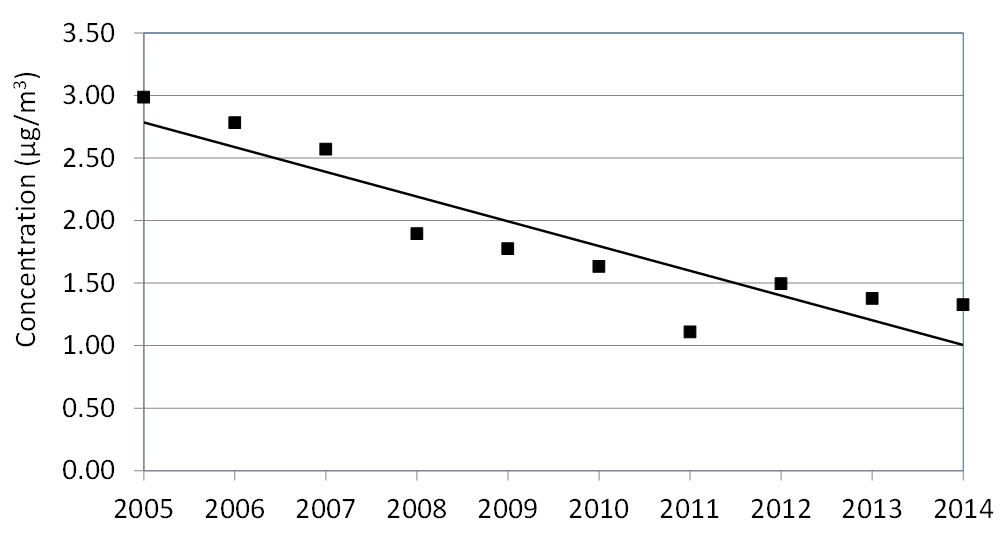
Note: 10-year trend is a composite mean based on 8 sites.
Ethylbenzene is a colourless liquid that smells like gasoline and is mainly used in the manufacture of styrene. Exposure to ethylbenzene occurs from the use of consumer products, fuel, pesticides, solvents, carpet glues, varnishes, paints and tobacco smoke. In humans, acute exposure results in respiratory effects; limited information is available on the carcinogenic effects of ethylbenzene (USEPA, 2016).
In 2014, ethylbenzene annual means ranged from 0.10 μg/m3 at Ottawa Downtown to 0.27 μg/m3 at Windsor West. There has been a 79 per cent decrease in ethylbenzene annual mean concentrations from 2005 to 2014 as shown in Figure 21.
Xylene is a colourless, sweet-smelling liquid or gas occurring naturally in petroleum, coal and wood tar; it is also used as a solvent in the printing, rubber, paint and leather industries. Xylene, also referred to as mixed xylenes, is a mixture of three isomers: ortho-, meta-, and para-xylene, commonly known as o-, m-, and p-xylene, which have the same molecular formula but different chemical structure, meaning the arrangement of their atoms are different. There is no information on the carcinogenic effects of mixed xylenes on humans (USEPA, 2016).
In 2014, m-, and p-xylene annual means ranged from 0.32 μg/m3 at Ottawa Downtown and London to 0.83 μg/m3 at Windsor West. The annual mean concentrations of o-xylene ranged from 0.12 μg/m3 at Ottawa Downtown to 0.29 μg/m3 at Windsor West. As shown in Figure 22, there has been an 85 per cent decrease in m-, and p-xylene annual mean concentrations from 2005 to 2014. Similarly, in Figure 23, o-xylene annual mean concentrations decreased 84 per cent over the same 10-year period.
Figure 21: Trend of Ethylbenzene Annual Means Across Ontario (2005 - 2014)
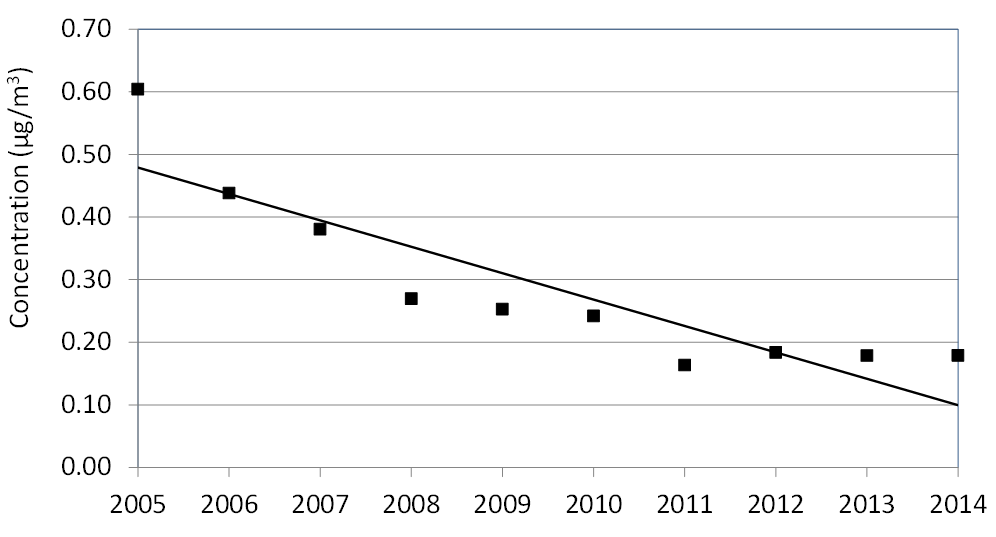
Note: 10-year trend is a composite mean based on 8 sites.
Figure 22: Trend of m- and p-xylene Annual Means Across Ontario (2005 - 2014)
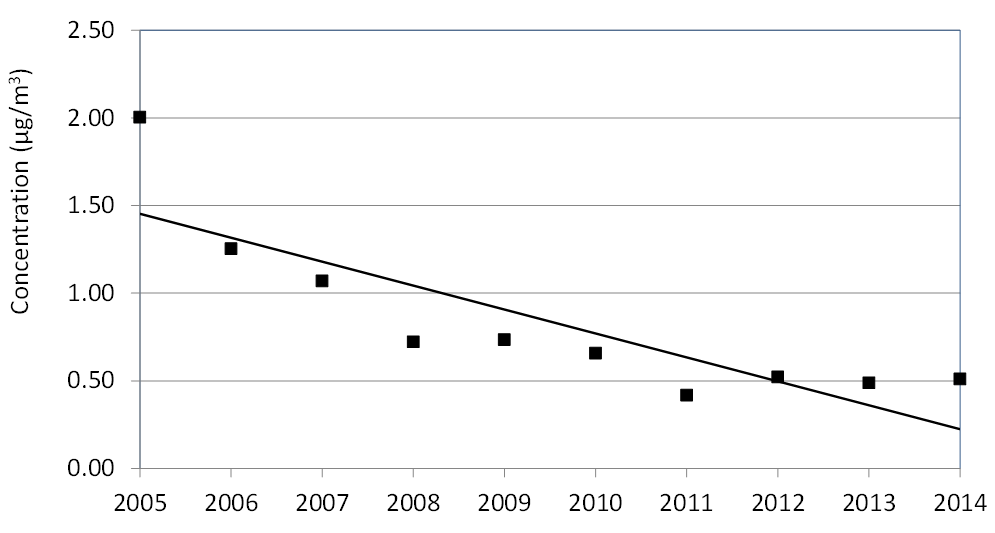
Note: 10-year trend is a composite mean based on 8 sites.
Figure 23: Trend of o-xylene Annual Means Across Ontario (2006 - 2015)
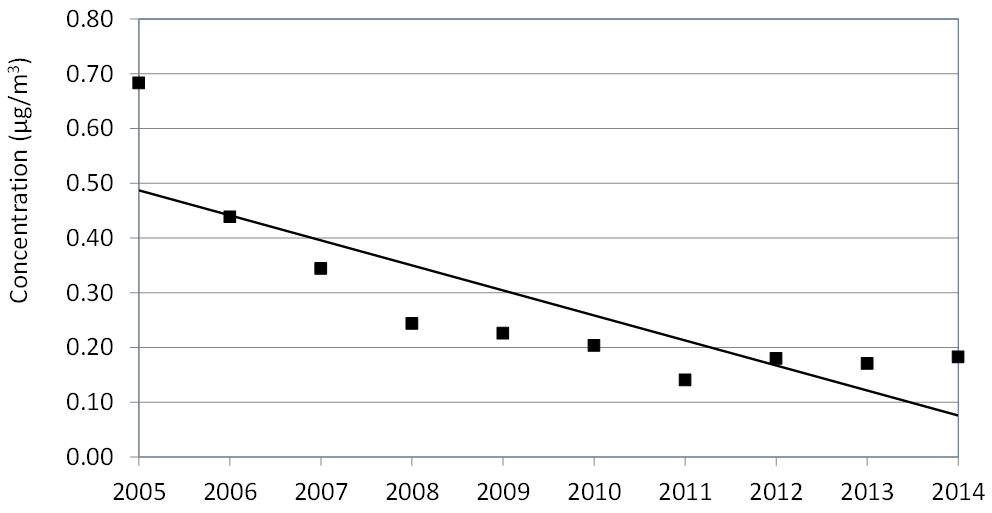
Note: 10-year trend is a composite mean based on 8 sites.
1,3-Butadiene
1,3-Butadiene is a colourless gas with a mild gasoline-like odour. It is released into the air through motor vehicle exhaust, manufacturing and processing facilities, forest fires or other combustion, and cigarette smoke. Acute exposure to 1,3-butadiene by inhalation in humans results in irritation of the eyes, nasal passages, throat and lung; in addition, 1,3-butadiene is carcinogenic in humans by inhalation (USEPA, 2016).
In 2014, 1,3-butadiene annual means ranged from 0.02 μg/m3 in Newmarket to 0.12 μg/m3 in Sarnia. The Ontario annual AAQC for 1,3-butadiene of 2 μg/m3 was met at each of the eight sites. Over the 10-year period, 2005 to 2014, 1,3-butadiene concentrations have decreased 62 per cent as shown in Figure 24.
Figure 24: Trend of 1,3-Butadiene Annual Means Across Ontario (2005 - 2014)
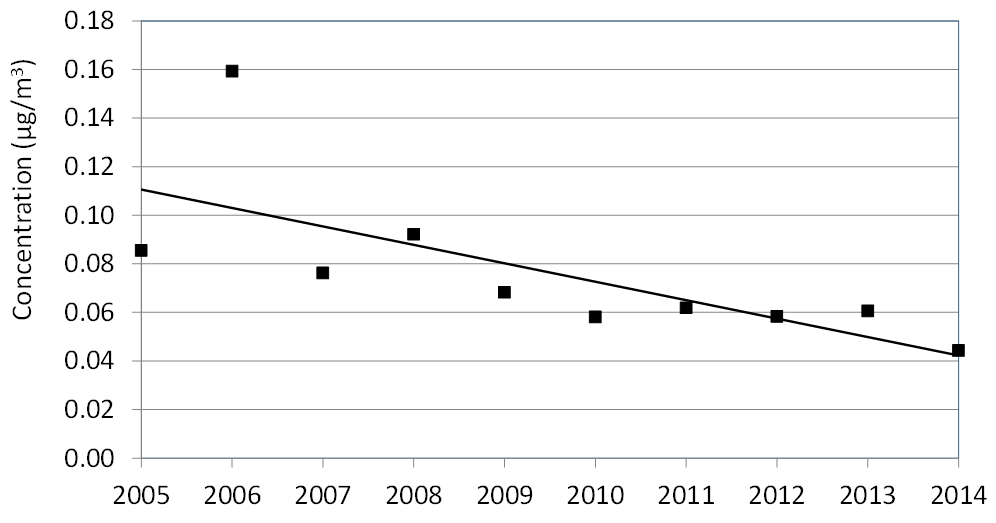
Note: 10-year trend is a composite mean based on 8 sites.